Report: Analyzing Buyer Behaviour, Consumer Psychology, and Issues
VerifiedAdded on 2021/02/22
|10
|2392
|79
Report
AI Summary
This report delves into the multifaceted realm of consumer buying behavior, providing a comprehensive analysis of the psychological underpinnings that drive purchasing decisions. It begins by exploring various consumer theories, including Marshallian Economics, Psychoanalytic theory, Pavlovian Theory, and Veblenian Social-Psychological Model, to understand how consumers are influenced. The report then critically examines contemporary issues impacting consumer behavior, such as the increasing importance of product quality, the role of incentives and budgeting, the influence of digital technology and social media, the impact of credit facilities, and the rise of eco-friendly products. The analysis highlights how these factors shape consumer preferences and buying habits in today's dynamic market landscape. The report emphasizes the importance of consumer research and adapting marketing strategies to address these evolving trends.
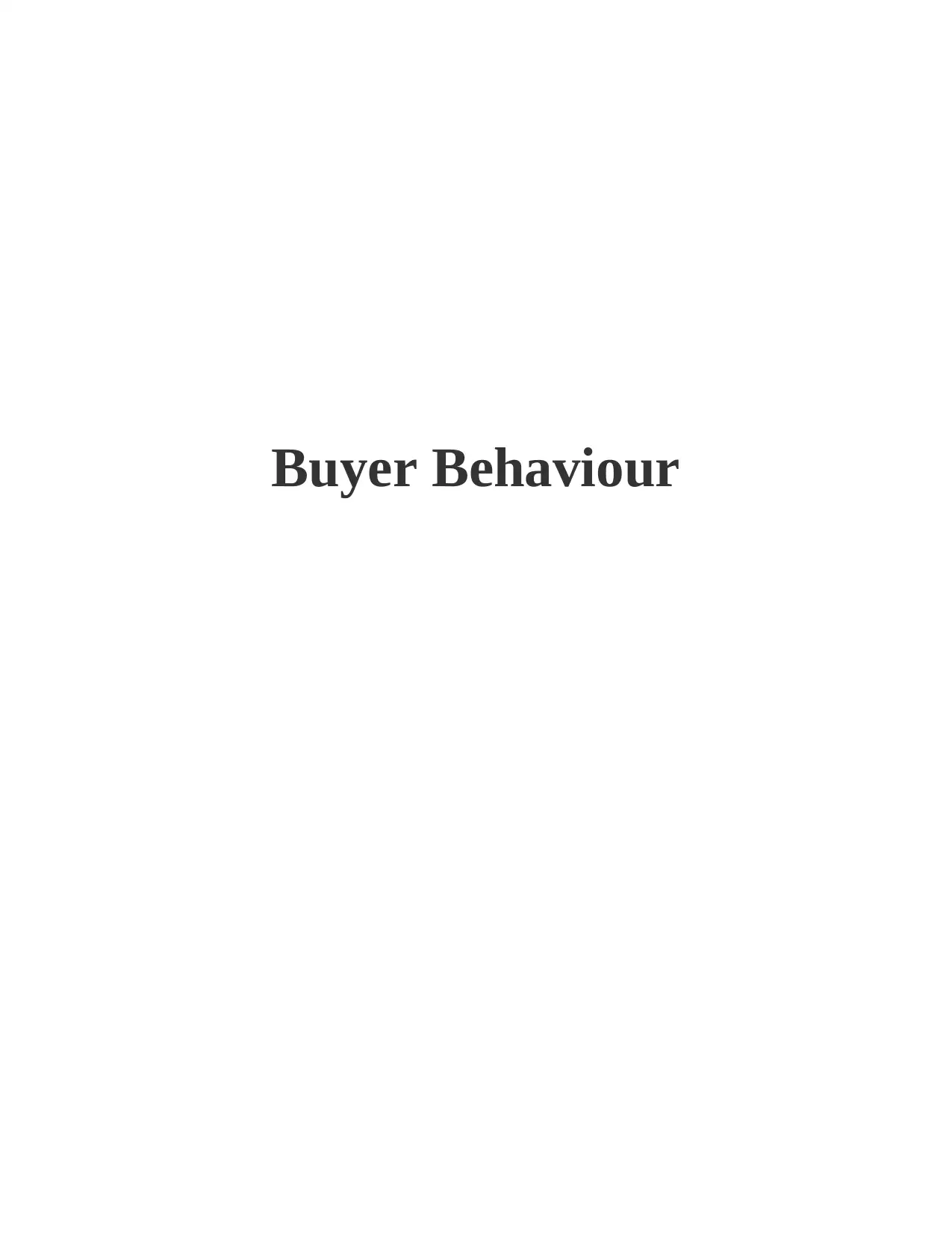
Buyer Behaviour
Paraphrase This Document
Need a fresh take? Get an instant paraphrase of this document with our AI Paraphraser
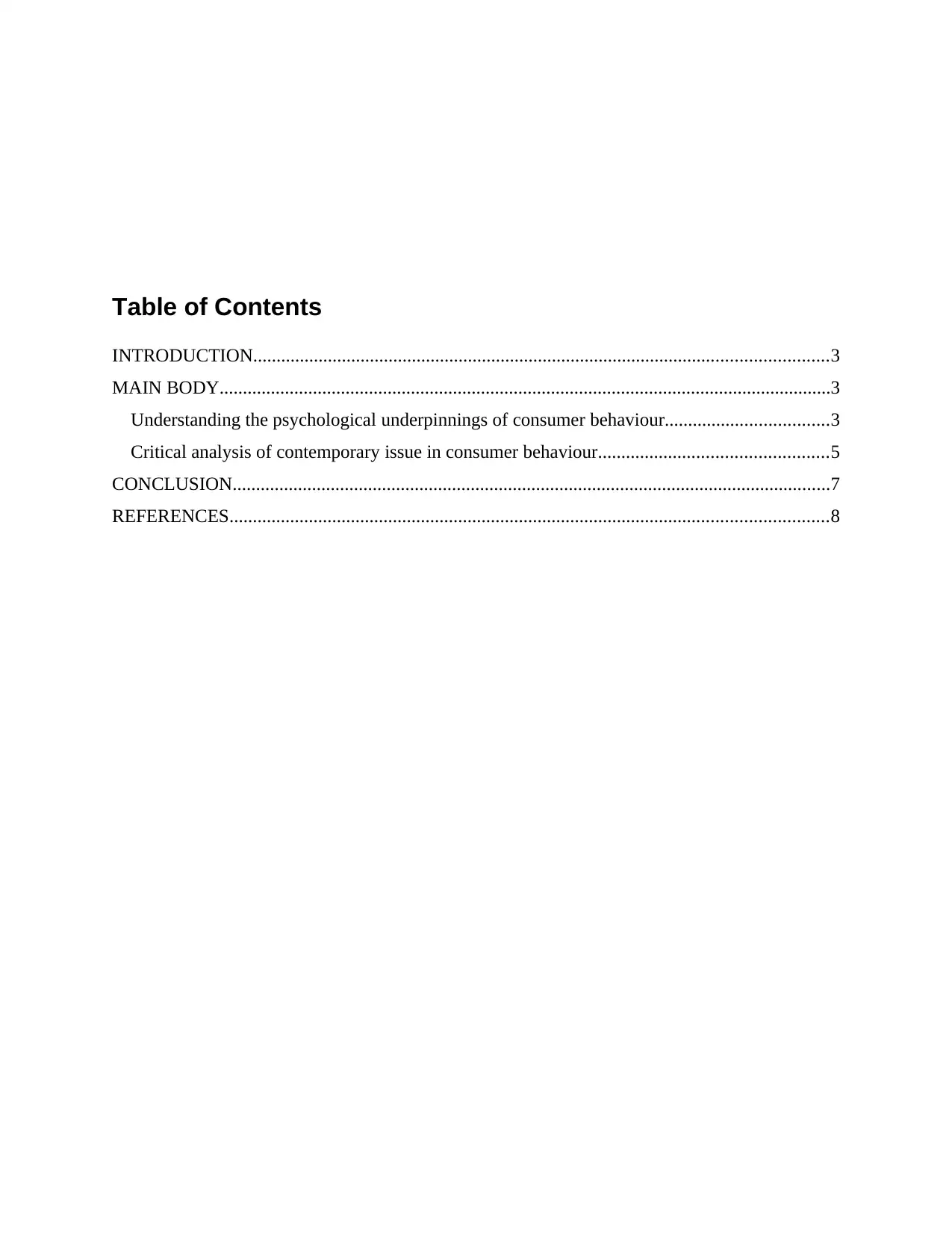
Table of Contents
INTRODUCTION...........................................................................................................................3
MAIN BODY...................................................................................................................................3
Understanding the psychological underpinnings of consumer behaviour...................................3
Critical analysis of contemporary issue in consumer behaviour.................................................5
CONCLUSION................................................................................................................................7
REFERENCES................................................................................................................................8
INTRODUCTION...........................................................................................................................3
MAIN BODY...................................................................................................................................3
Understanding the psychological underpinnings of consumer behaviour...................................3
Critical analysis of contemporary issue in consumer behaviour.................................................5
CONCLUSION................................................................................................................................7
REFERENCES................................................................................................................................8
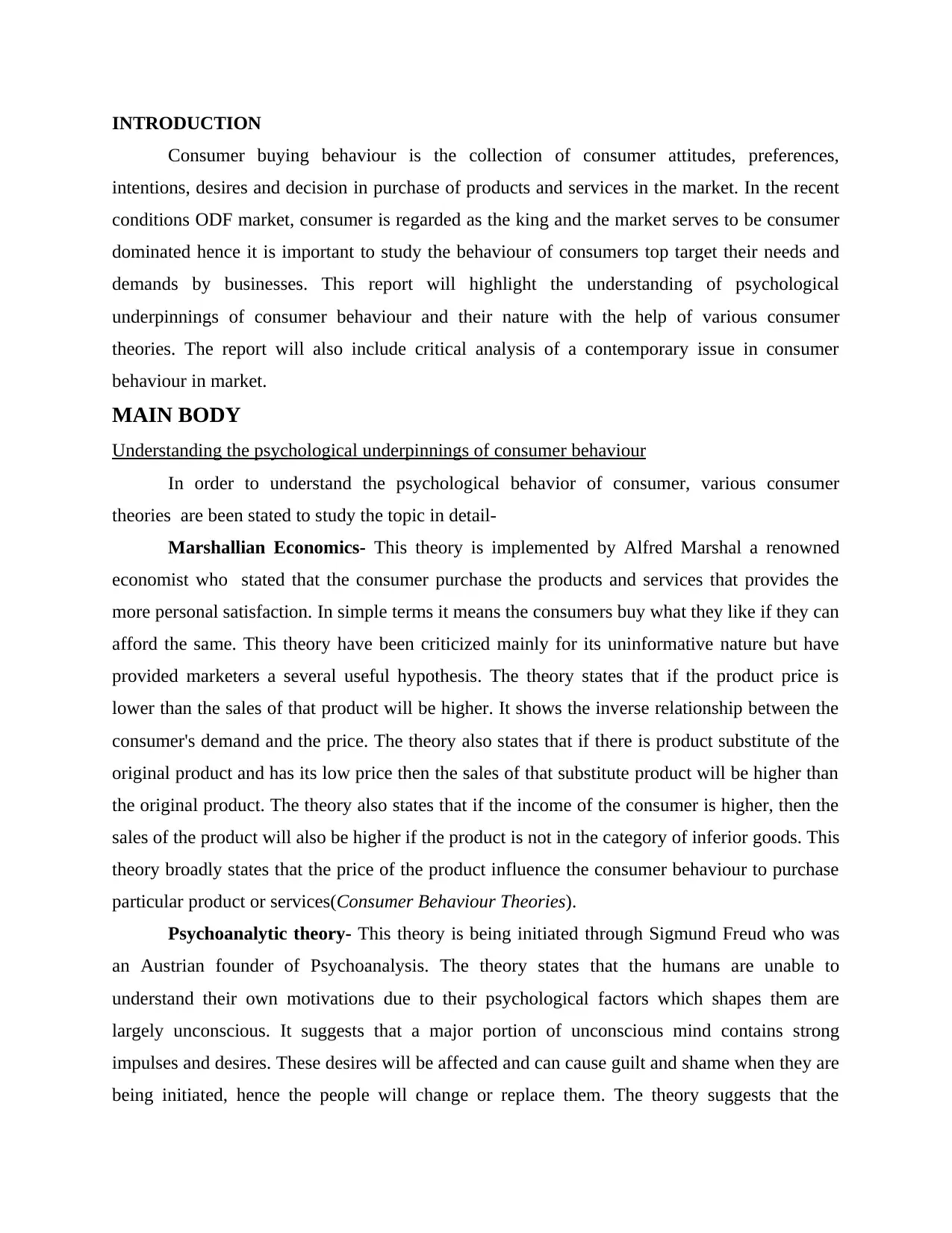
INTRODUCTION
Consumer buying behaviour is the collection of consumer attitudes, preferences,
intentions, desires and decision in purchase of products and services in the market. In the recent
conditions ODF market, consumer is regarded as the king and the market serves to be consumer
dominated hence it is important to study the behaviour of consumers top target their needs and
demands by businesses. This report will highlight the understanding of psychological
underpinnings of consumer behaviour and their nature with the help of various consumer
theories. The report will also include critical analysis of a contemporary issue in consumer
behaviour in market.
MAIN BODY
Understanding the psychological underpinnings of consumer behaviour
In order to understand the psychological behavior of consumer, various consumer
theories are been stated to study the topic in detail-
Marshallian Economics- This theory is implemented by Alfred Marshal a renowned
economist who stated that the consumer purchase the products and services that provides the
more personal satisfaction. In simple terms it means the consumers buy what they like if they can
afford the same. This theory have been criticized mainly for its uninformative nature but have
provided marketers a several useful hypothesis. The theory states that if the product price is
lower than the sales of that product will be higher. It shows the inverse relationship between the
consumer's demand and the price. The theory also states that if there is product substitute of the
original product and has its low price then the sales of that substitute product will be higher than
the original product. The theory also states that if the income of the consumer is higher, then the
sales of the product will also be higher if the product is not in the category of inferior goods. This
theory broadly states that the price of the product influence the consumer behaviour to purchase
particular product or services(Consumer Behaviour Theories).
Psychoanalytic theory- This theory is being initiated through Sigmund Freud who was
an Austrian founder of Psychoanalysis. The theory states that the humans are unable to
understand their own motivations due to their psychological factors which shapes them are
largely unconscious. It suggests that a major portion of unconscious mind contains strong
impulses and desires. These desires will be affected and can cause guilt and shame when they are
being initiated, hence the people will change or replace them. The theory suggests that the
Consumer buying behaviour is the collection of consumer attitudes, preferences,
intentions, desires and decision in purchase of products and services in the market. In the recent
conditions ODF market, consumer is regarded as the king and the market serves to be consumer
dominated hence it is important to study the behaviour of consumers top target their needs and
demands by businesses. This report will highlight the understanding of psychological
underpinnings of consumer behaviour and their nature with the help of various consumer
theories. The report will also include critical analysis of a contemporary issue in consumer
behaviour in market.
MAIN BODY
Understanding the psychological underpinnings of consumer behaviour
In order to understand the psychological behavior of consumer, various consumer
theories are been stated to study the topic in detail-
Marshallian Economics- This theory is implemented by Alfred Marshal a renowned
economist who stated that the consumer purchase the products and services that provides the
more personal satisfaction. In simple terms it means the consumers buy what they like if they can
afford the same. This theory have been criticized mainly for its uninformative nature but have
provided marketers a several useful hypothesis. The theory states that if the product price is
lower than the sales of that product will be higher. It shows the inverse relationship between the
consumer's demand and the price. The theory also states that if there is product substitute of the
original product and has its low price then the sales of that substitute product will be higher than
the original product. The theory also states that if the income of the consumer is higher, then the
sales of the product will also be higher if the product is not in the category of inferior goods. This
theory broadly states that the price of the product influence the consumer behaviour to purchase
particular product or services(Consumer Behaviour Theories).
Psychoanalytic theory- This theory is being initiated through Sigmund Freud who was
an Austrian founder of Psychoanalysis. The theory states that the humans are unable to
understand their own motivations due to their psychological factors which shapes them are
largely unconscious. It suggests that a major portion of unconscious mind contains strong
impulses and desires. These desires will be affected and can cause guilt and shame when they are
being initiated, hence the people will change or replace them. The theory suggests that the
⊘ This is a preview!⊘
Do you want full access?
Subscribe today to unlock all pages.

Trusted by 1+ million students worldwide
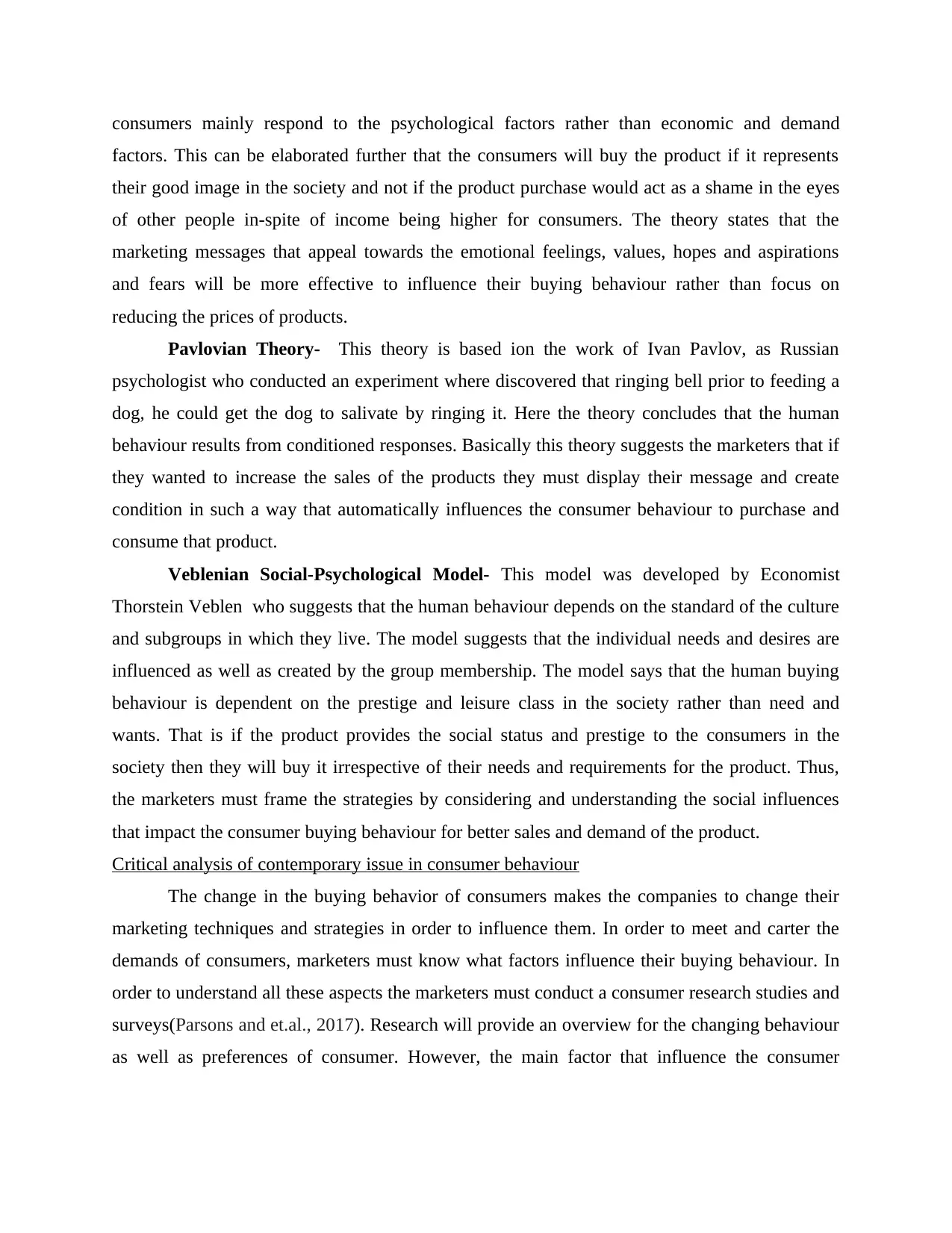
consumers mainly respond to the psychological factors rather than economic and demand
factors. This can be elaborated further that the consumers will buy the product if it represents
their good image in the society and not if the product purchase would act as a shame in the eyes
of other people in-spite of income being higher for consumers. The theory states that the
marketing messages that appeal towards the emotional feelings, values, hopes and aspirations
and fears will be more effective to influence their buying behaviour rather than focus on
reducing the prices of products.
Pavlovian Theory- This theory is based ion the work of Ivan Pavlov, as Russian
psychologist who conducted an experiment where discovered that ringing bell prior to feeding a
dog, he could get the dog to salivate by ringing it. Here the theory concludes that the human
behaviour results from conditioned responses. Basically this theory suggests the marketers that if
they wanted to increase the sales of the products they must display their message and create
condition in such a way that automatically influences the consumer behaviour to purchase and
consume that product.
Veblenian Social-Psychological Model- This model was developed by Economist
Thorstein Veblen who suggests that the human behaviour depends on the standard of the culture
and subgroups in which they live. The model suggests that the individual needs and desires are
influenced as well as created by the group membership. The model says that the human buying
behaviour is dependent on the prestige and leisure class in the society rather than need and
wants. That is if the product provides the social status and prestige to the consumers in the
society then they will buy it irrespective of their needs and requirements for the product. Thus,
the marketers must frame the strategies by considering and understanding the social influences
that impact the consumer buying behaviour for better sales and demand of the product.
Critical analysis of contemporary issue in consumer behaviour
The change in the buying behavior of consumers makes the companies to change their
marketing techniques and strategies in order to influence them. In order to meet and carter the
demands of consumers, marketers must know what factors influence their buying behaviour. In
order to understand all these aspects the marketers must conduct a consumer research studies and
surveys(Parsons and et.al., 2017). Research will provide an overview for the changing behaviour
as well as preferences of consumer. However, the main factor that influence the consumer
factors. This can be elaborated further that the consumers will buy the product if it represents
their good image in the society and not if the product purchase would act as a shame in the eyes
of other people in-spite of income being higher for consumers. The theory states that the
marketing messages that appeal towards the emotional feelings, values, hopes and aspirations
and fears will be more effective to influence their buying behaviour rather than focus on
reducing the prices of products.
Pavlovian Theory- This theory is based ion the work of Ivan Pavlov, as Russian
psychologist who conducted an experiment where discovered that ringing bell prior to feeding a
dog, he could get the dog to salivate by ringing it. Here the theory concludes that the human
behaviour results from conditioned responses. Basically this theory suggests the marketers that if
they wanted to increase the sales of the products they must display their message and create
condition in such a way that automatically influences the consumer behaviour to purchase and
consume that product.
Veblenian Social-Psychological Model- This model was developed by Economist
Thorstein Veblen who suggests that the human behaviour depends on the standard of the culture
and subgroups in which they live. The model suggests that the individual needs and desires are
influenced as well as created by the group membership. The model says that the human buying
behaviour is dependent on the prestige and leisure class in the society rather than need and
wants. That is if the product provides the social status and prestige to the consumers in the
society then they will buy it irrespective of their needs and requirements for the product. Thus,
the marketers must frame the strategies by considering and understanding the social influences
that impact the consumer buying behaviour for better sales and demand of the product.
Critical analysis of contemporary issue in consumer behaviour
The change in the buying behavior of consumers makes the companies to change their
marketing techniques and strategies in order to influence them. In order to meet and carter the
demands of consumers, marketers must know what factors influence their buying behaviour. In
order to understand all these aspects the marketers must conduct a consumer research studies and
surveys(Parsons and et.al., 2017). Research will provide an overview for the changing behaviour
as well as preferences of consumer. However, the main factor that influence the consumer
Paraphrase This Document
Need a fresh take? Get an instant paraphrase of this document with our AI Paraphraser
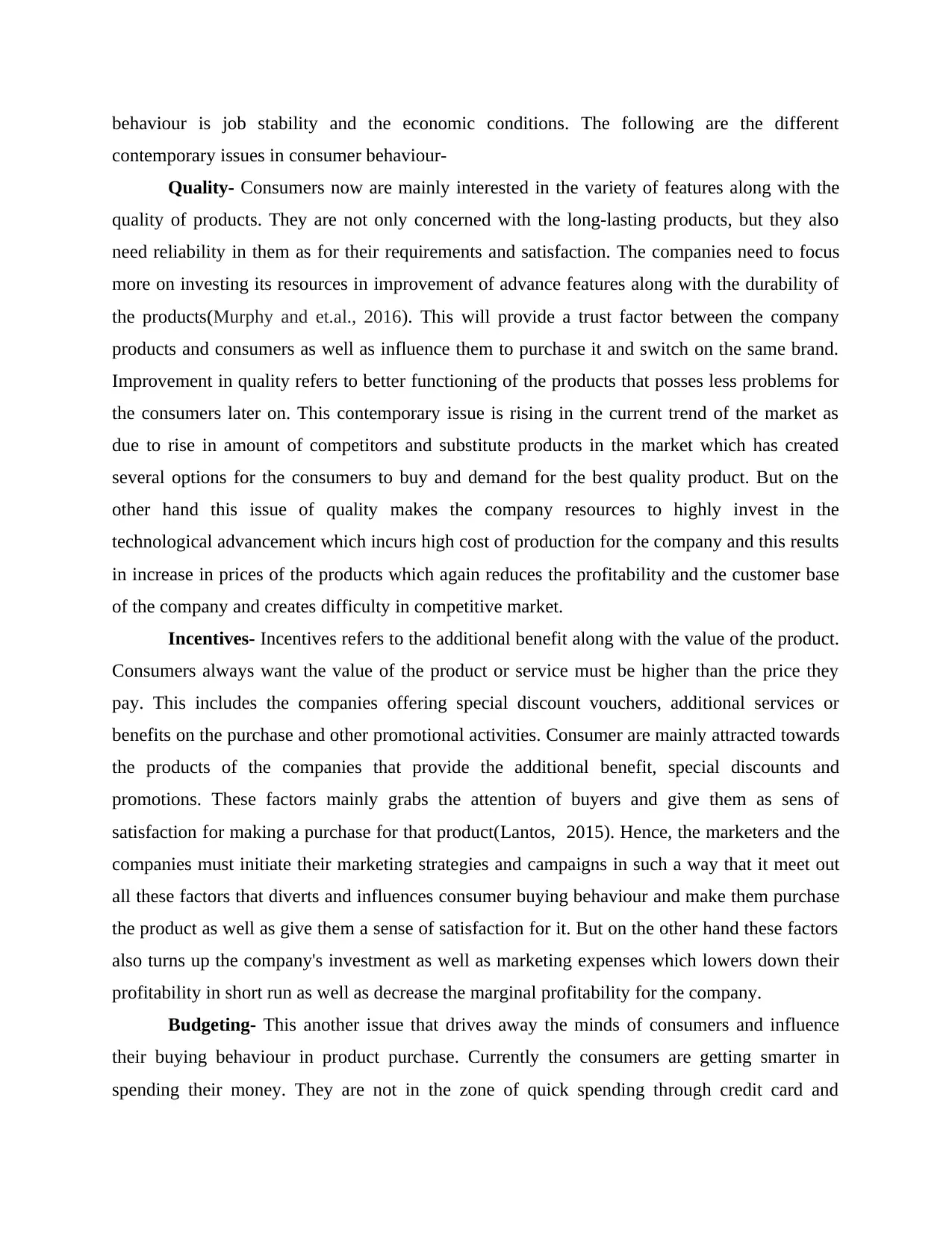
behaviour is job stability and the economic conditions. The following are the different
contemporary issues in consumer behaviour-
Quality- Consumers now are mainly interested in the variety of features along with the
quality of products. They are not only concerned with the long-lasting products, but they also
need reliability in them as for their requirements and satisfaction. The companies need to focus
more on investing its resources in improvement of advance features along with the durability of
the products(Murphy and et.al., 2016). This will provide a trust factor between the company
products and consumers as well as influence them to purchase it and switch on the same brand.
Improvement in quality refers to better functioning of the products that posses less problems for
the consumers later on. This contemporary issue is rising in the current trend of the market as
due to rise in amount of competitors and substitute products in the market which has created
several options for the consumers to buy and demand for the best quality product. But on the
other hand this issue of quality makes the company resources to highly invest in the
technological advancement which incurs high cost of production for the company and this results
in increase in prices of the products which again reduces the profitability and the customer base
of the company and creates difficulty in competitive market.
Incentives- Incentives refers to the additional benefit along with the value of the product.
Consumers always want the value of the product or service must be higher than the price they
pay. This includes the companies offering special discount vouchers, additional services or
benefits on the purchase and other promotional activities. Consumer are mainly attracted towards
the products of the companies that provide the additional benefit, special discounts and
promotions. These factors mainly grabs the attention of buyers and give them as sens of
satisfaction for making a purchase for that product(Lantos, 2015). Hence, the marketers and the
companies must initiate their marketing strategies and campaigns in such a way that it meet out
all these factors that diverts and influences consumer buying behaviour and make them purchase
the product as well as give them a sense of satisfaction for it. But on the other hand these factors
also turns up the company's investment as well as marketing expenses which lowers down their
profitability in short run as well as decrease the marginal profitability for the company.
Budgeting- This another issue that drives away the minds of consumers and influence
their buying behaviour in product purchase. Currently the consumers are getting smarter in
spending their money. They are not in the zone of quick spending through credit card and
contemporary issues in consumer behaviour-
Quality- Consumers now are mainly interested in the variety of features along with the
quality of products. They are not only concerned with the long-lasting products, but they also
need reliability in them as for their requirements and satisfaction. The companies need to focus
more on investing its resources in improvement of advance features along with the durability of
the products(Murphy and et.al., 2016). This will provide a trust factor between the company
products and consumers as well as influence them to purchase it and switch on the same brand.
Improvement in quality refers to better functioning of the products that posses less problems for
the consumers later on. This contemporary issue is rising in the current trend of the market as
due to rise in amount of competitors and substitute products in the market which has created
several options for the consumers to buy and demand for the best quality product. But on the
other hand this issue of quality makes the company resources to highly invest in the
technological advancement which incurs high cost of production for the company and this results
in increase in prices of the products which again reduces the profitability and the customer base
of the company and creates difficulty in competitive market.
Incentives- Incentives refers to the additional benefit along with the value of the product.
Consumers always want the value of the product or service must be higher than the price they
pay. This includes the companies offering special discount vouchers, additional services or
benefits on the purchase and other promotional activities. Consumer are mainly attracted towards
the products of the companies that provide the additional benefit, special discounts and
promotions. These factors mainly grabs the attention of buyers and give them as sens of
satisfaction for making a purchase for that product(Lantos, 2015). Hence, the marketers and the
companies must initiate their marketing strategies and campaigns in such a way that it meet out
all these factors that diverts and influences consumer buying behaviour and make them purchase
the product as well as give them a sense of satisfaction for it. But on the other hand these factors
also turns up the company's investment as well as marketing expenses which lowers down their
profitability in short run as well as decrease the marginal profitability for the company.
Budgeting- This another issue that drives away the minds of consumers and influence
their buying behaviour in product purchase. Currently the consumers are getting smarter in
spending their money. They are not in the zone of quick spending through credit card and
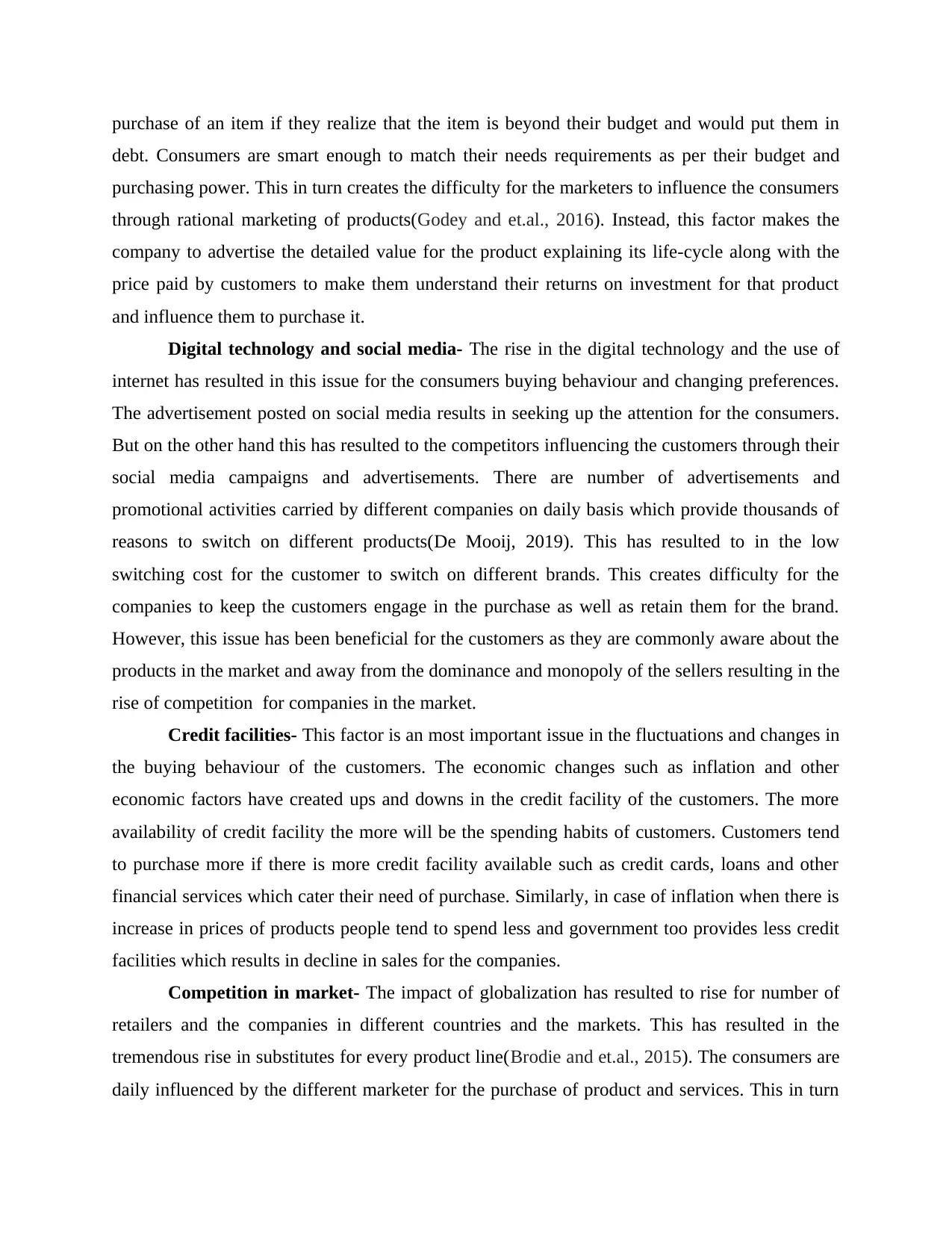
purchase of an item if they realize that the item is beyond their budget and would put them in
debt. Consumers are smart enough to match their needs requirements as per their budget and
purchasing power. This in turn creates the difficulty for the marketers to influence the consumers
through rational marketing of products(Godey and et.al., 2016). Instead, this factor makes the
company to advertise the detailed value for the product explaining its life-cycle along with the
price paid by customers to make them understand their returns on investment for that product
and influence them to purchase it.
Digital technology and social media- The rise in the digital technology and the use of
internet has resulted in this issue for the consumers buying behaviour and changing preferences.
The advertisement posted on social media results in seeking up the attention for the consumers.
But on the other hand this has resulted to the competitors influencing the customers through their
social media campaigns and advertisements. There are number of advertisements and
promotional activities carried by different companies on daily basis which provide thousands of
reasons to switch on different products(De Mooij, 2019). This has resulted to in the low
switching cost for the customer to switch on different brands. This creates difficulty for the
companies to keep the customers engage in the purchase as well as retain them for the brand.
However, this issue has been beneficial for the customers as they are commonly aware about the
products in the market and away from the dominance and monopoly of the sellers resulting in the
rise of competition for companies in the market.
Credit facilities- This factor is an most important issue in the fluctuations and changes in
the buying behaviour of the customers. The economic changes such as inflation and other
economic factors have created ups and downs in the credit facility of the customers. The more
availability of credit facility the more will be the spending habits of customers. Customers tend
to purchase more if there is more credit facility available such as credit cards, loans and other
financial services which cater their need of purchase. Similarly, in case of inflation when there is
increase in prices of products people tend to spend less and government too provides less credit
facilities which results in decline in sales for the companies.
Competition in market- The impact of globalization has resulted to rise for number of
retailers and the companies in different countries and the markets. This has resulted in the
tremendous rise in substitutes for every product line(Brodie and et.al., 2015). The consumers are
daily influenced by the different marketer for the purchase of product and services. This in turn
debt. Consumers are smart enough to match their needs requirements as per their budget and
purchasing power. This in turn creates the difficulty for the marketers to influence the consumers
through rational marketing of products(Godey and et.al., 2016). Instead, this factor makes the
company to advertise the detailed value for the product explaining its life-cycle along with the
price paid by customers to make them understand their returns on investment for that product
and influence them to purchase it.
Digital technology and social media- The rise in the digital technology and the use of
internet has resulted in this issue for the consumers buying behaviour and changing preferences.
The advertisement posted on social media results in seeking up the attention for the consumers.
But on the other hand this has resulted to the competitors influencing the customers through their
social media campaigns and advertisements. There are number of advertisements and
promotional activities carried by different companies on daily basis which provide thousands of
reasons to switch on different products(De Mooij, 2019). This has resulted to in the low
switching cost for the customer to switch on different brands. This creates difficulty for the
companies to keep the customers engage in the purchase as well as retain them for the brand.
However, this issue has been beneficial for the customers as they are commonly aware about the
products in the market and away from the dominance and monopoly of the sellers resulting in the
rise of competition for companies in the market.
Credit facilities- This factor is an most important issue in the fluctuations and changes in
the buying behaviour of the customers. The economic changes such as inflation and other
economic factors have created ups and downs in the credit facility of the customers. The more
availability of credit facility the more will be the spending habits of customers. Customers tend
to purchase more if there is more credit facility available such as credit cards, loans and other
financial services which cater their need of purchase. Similarly, in case of inflation when there is
increase in prices of products people tend to spend less and government too provides less credit
facilities which results in decline in sales for the companies.
Competition in market- The impact of globalization has resulted to rise for number of
retailers and the companies in different countries and the markets. This has resulted in the
tremendous rise in substitutes for every product line(Brodie and et.al., 2015). The consumers are
daily influenced by the different marketer for the purchase of product and services. This in turn
⊘ This is a preview!⊘
Do you want full access?
Subscribe today to unlock all pages.

Trusted by 1+ million students worldwide
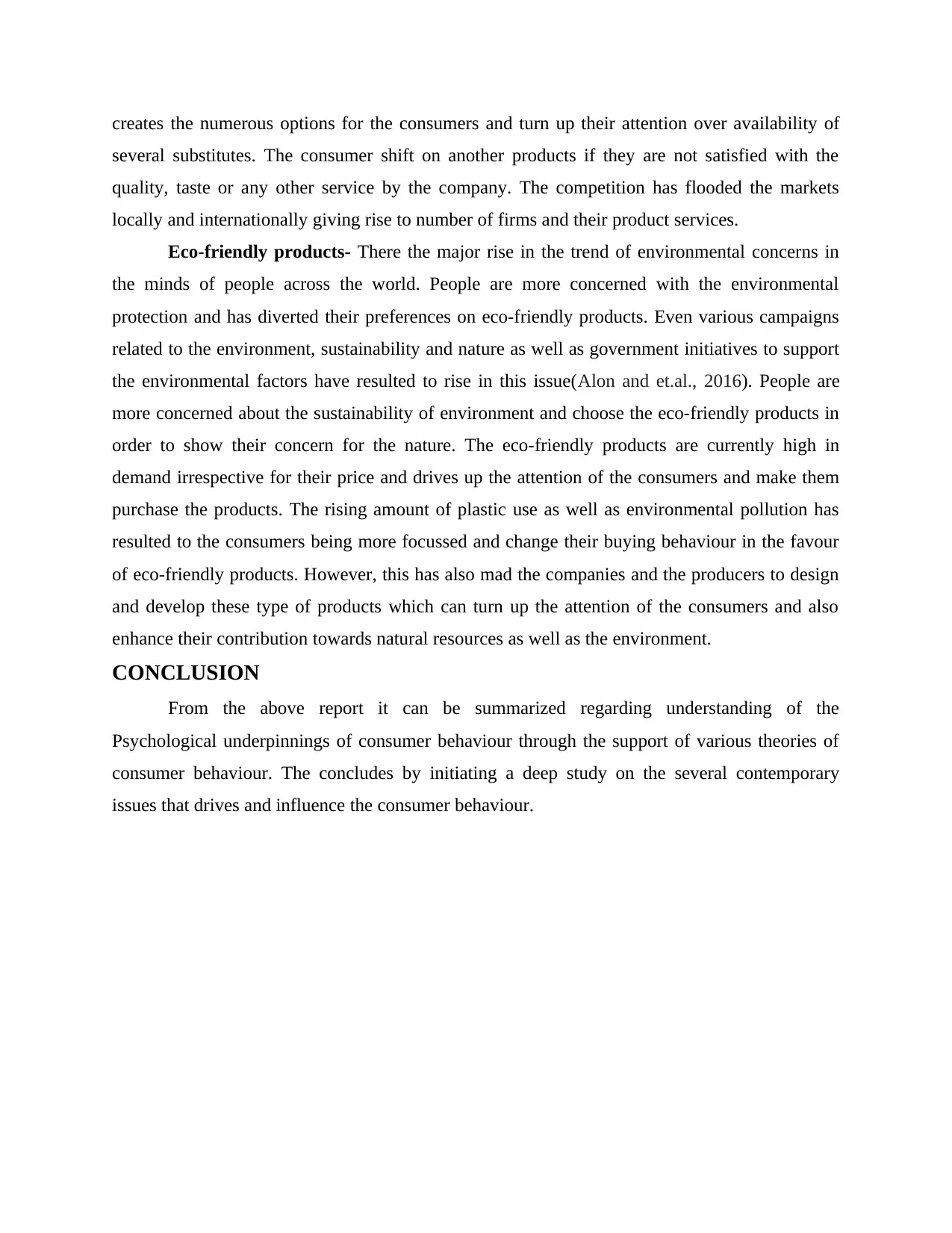
creates the numerous options for the consumers and turn up their attention over availability of
several substitutes. The consumer shift on another products if they are not satisfied with the
quality, taste or any other service by the company. The competition has flooded the markets
locally and internationally giving rise to number of firms and their product services.
Eco-friendly products- There the major rise in the trend of environmental concerns in
the minds of people across the world. People are more concerned with the environmental
protection and has diverted their preferences on eco-friendly products. Even various campaigns
related to the environment, sustainability and nature as well as government initiatives to support
the environmental factors have resulted to rise in this issue(Alon and et.al., 2016). People are
more concerned about the sustainability of environment and choose the eco-friendly products in
order to show their concern for the nature. The eco-friendly products are currently high in
demand irrespective for their price and drives up the attention of the consumers and make them
purchase the products. The rising amount of plastic use as well as environmental pollution has
resulted to the consumers being more focussed and change their buying behaviour in the favour
of eco-friendly products. However, this has also mad the companies and the producers to design
and develop these type of products which can turn up the attention of the consumers and also
enhance their contribution towards natural resources as well as the environment.
CONCLUSION
From the above report it can be summarized regarding understanding of the
Psychological underpinnings of consumer behaviour through the support of various theories of
consumer behaviour. The concludes by initiating a deep study on the several contemporary
issues that drives and influence the consumer behaviour.
several substitutes. The consumer shift on another products if they are not satisfied with the
quality, taste or any other service by the company. The competition has flooded the markets
locally and internationally giving rise to number of firms and their product services.
Eco-friendly products- There the major rise in the trend of environmental concerns in
the minds of people across the world. People are more concerned with the environmental
protection and has diverted their preferences on eco-friendly products. Even various campaigns
related to the environment, sustainability and nature as well as government initiatives to support
the environmental factors have resulted to rise in this issue(Alon and et.al., 2016). People are
more concerned about the sustainability of environment and choose the eco-friendly products in
order to show their concern for the nature. The eco-friendly products are currently high in
demand irrespective for their price and drives up the attention of the consumers and make them
purchase the products. The rising amount of plastic use as well as environmental pollution has
resulted to the consumers being more focussed and change their buying behaviour in the favour
of eco-friendly products. However, this has also mad the companies and the producers to design
and develop these type of products which can turn up the attention of the consumers and also
enhance their contribution towards natural resources as well as the environment.
CONCLUSION
From the above report it can be summarized regarding understanding of the
Psychological underpinnings of consumer behaviour through the support of various theories of
consumer behaviour. The concludes by initiating a deep study on the several contemporary
issues that drives and influence the consumer behaviour.
Paraphrase This Document
Need a fresh take? Get an instant paraphrase of this document with our AI Paraphraser
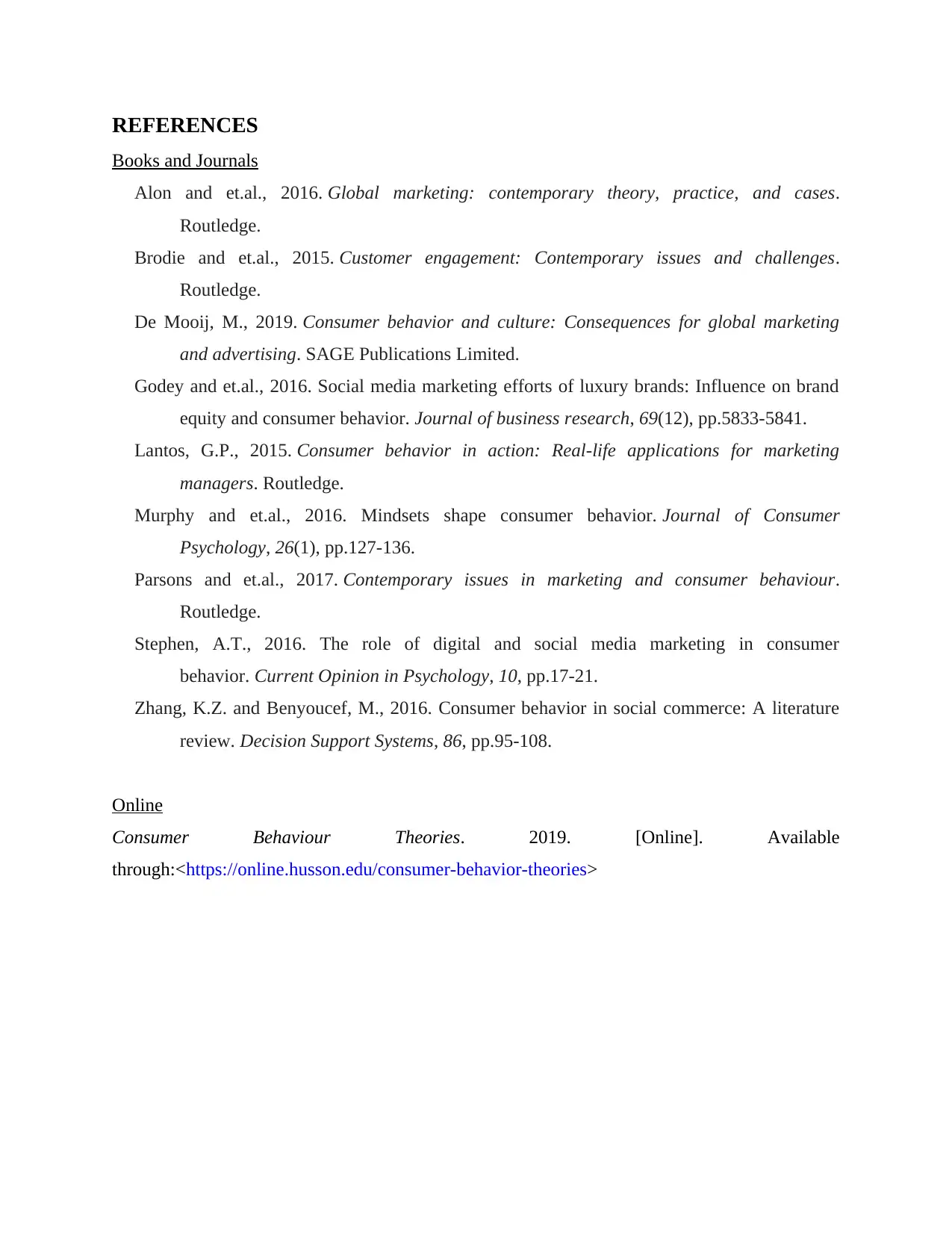
REFERENCES
Books and Journals
Alon and et.al., 2016. Global marketing: contemporary theory, practice, and cases.
Routledge.
Brodie and et.al., 2015. Customer engagement: Contemporary issues and challenges.
Routledge.
De Mooij, M., 2019. Consumer behavior and culture: Consequences for global marketing
and advertising. SAGE Publications Limited.
Godey and et.al., 2016. Social media marketing efforts of luxury brands: Influence on brand
equity and consumer behavior. Journal of business research, 69(12), pp.5833-5841.
Lantos, G.P., 2015. Consumer behavior in action: Real-life applications for marketing
managers. Routledge.
Murphy and et.al., 2016. Mindsets shape consumer behavior. Journal of Consumer
Psychology, 26(1), pp.127-136.
Parsons and et.al., 2017. Contemporary issues in marketing and consumer behaviour.
Routledge.
Stephen, A.T., 2016. The role of digital and social media marketing in consumer
behavior. Current Opinion in Psychology, 10, pp.17-21.
Zhang, K.Z. and Benyoucef, M., 2016. Consumer behavior in social commerce: A literature
review. Decision Support Systems, 86, pp.95-108.
Online
Consumer Behaviour Theories. 2019. [Online]. Available
through:<https://online.husson.edu/consumer-behavior-theories>
Books and Journals
Alon and et.al., 2016. Global marketing: contemporary theory, practice, and cases.
Routledge.
Brodie and et.al., 2015. Customer engagement: Contemporary issues and challenges.
Routledge.
De Mooij, M., 2019. Consumer behavior and culture: Consequences for global marketing
and advertising. SAGE Publications Limited.
Godey and et.al., 2016. Social media marketing efforts of luxury brands: Influence on brand
equity and consumer behavior. Journal of business research, 69(12), pp.5833-5841.
Lantos, G.P., 2015. Consumer behavior in action: Real-life applications for marketing
managers. Routledge.
Murphy and et.al., 2016. Mindsets shape consumer behavior. Journal of Consumer
Psychology, 26(1), pp.127-136.
Parsons and et.al., 2017. Contemporary issues in marketing and consumer behaviour.
Routledge.
Stephen, A.T., 2016. The role of digital and social media marketing in consumer
behavior. Current Opinion in Psychology, 10, pp.17-21.
Zhang, K.Z. and Benyoucef, M., 2016. Consumer behavior in social commerce: A literature
review. Decision Support Systems, 86, pp.95-108.
Online
Consumer Behaviour Theories. 2019. [Online]. Available
through:<https://online.husson.edu/consumer-behavior-theories>

⊘ This is a preview!⊘
Do you want full access?
Subscribe today to unlock all pages.

Trusted by 1+ million students worldwide

1 out of 10
Related Documents
Your All-in-One AI-Powered Toolkit for Academic Success.
+13062052269
info@desklib.com
Available 24*7 on WhatsApp / Email
![[object Object]](/_next/static/media/star-bottom.7253800d.svg)
Unlock your academic potential
Copyright © 2020–2025 A2Z Services. All Rights Reserved. Developed and managed by ZUCOL.





